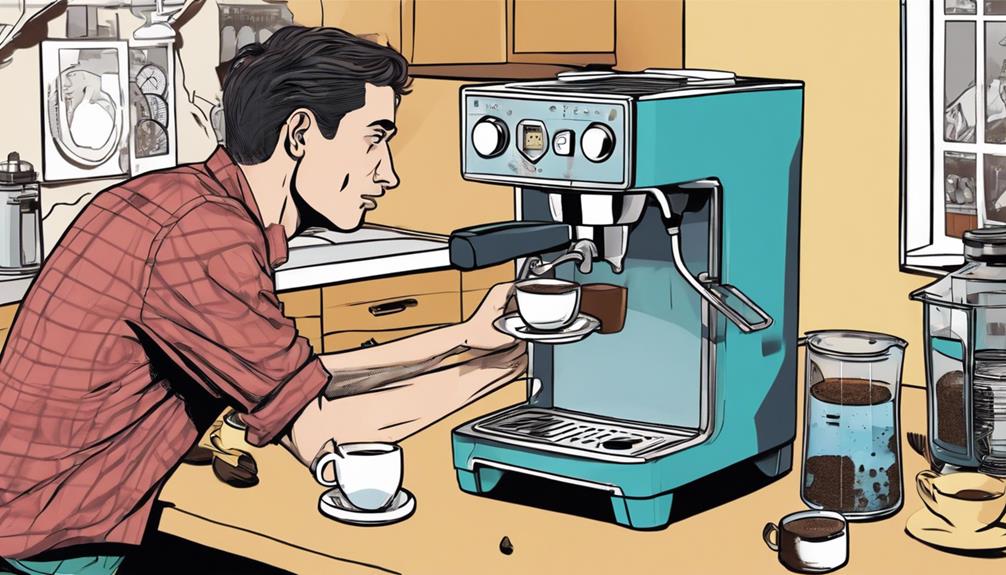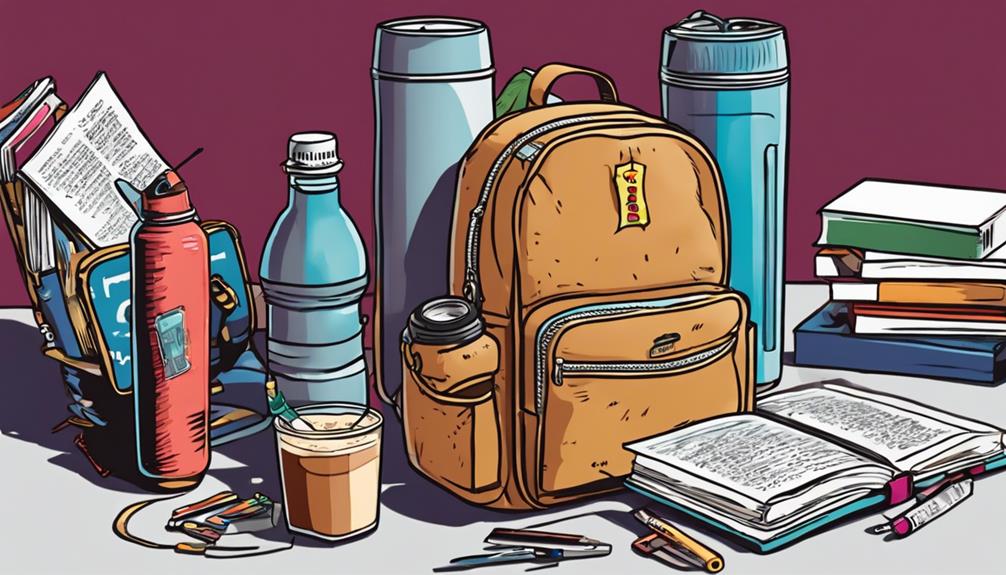To set up your coffee machine, start by collecting your standard drip maker, filter, and ground coffee. Position the filter properly and add the coffee grounds. Adjust the water level and brewing time to your liking. Double-check that everything is secure before beginning. For the best flavor, use filtered water. By following these steps diligently, you’ll be well on your way to brewing the ideal cup.
Key Takeaways
- Place filter in basket or cone, ensuring proper fit.
- Measure coffee grounds accurately for desired strength.
- Fill water reservoir with correct amount for brewing.
- Double-check settings for quantity and strength before brewing.
- Ensure all components are aligned and securely attached.
Equipment Needed
Gather the essential equipment for assembling your coffee machine, including a standard electric drip coffee maker, a wooden rolling pin, a coffee filter, and a saucepan larger than 2 quarts.
The coffee maker will be your brewing vessel, where hot water will mix with ground beans to create your perfect cup of joe. To assure a smooth brewing process, have your coffee filter ready to strain the brewed coffee and a wooden rolling pin to crush any whole beans if needed.
Additionally, two 1-quart canning jars with lids will be handy for storing any leftover brewed coffee.
Ingredients Required
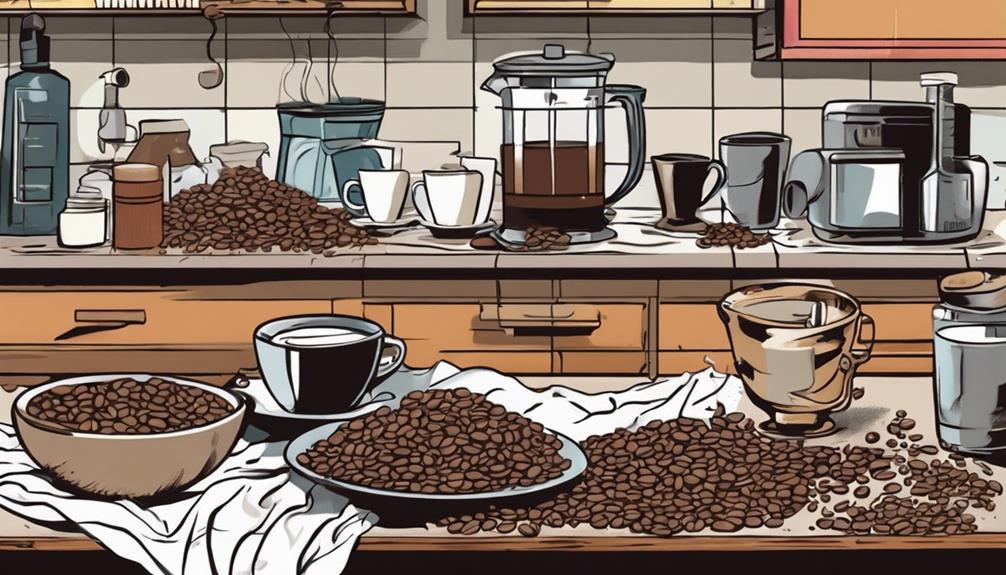
To secure a flavorful cup of coffee, the next step is to gather the necessary ingredients for brewing. You'll need 45 oz / 1250 ml of filtered water and 2.75 oz / 65 g of medium ground coffee.
Make sure to use a paper filter, whether cone or wavy basket, in your drip coffee maker to ensure a smooth brew. If your coffee beans aren't already ground to a medium consistency, consider using a grinder for the best size.
Feel free to adjust the water amount based on any experiments you wish to conduct, such as making iced coffee. Remember, the quality of the water and the freshness of the coffee grounds play a significant role in enhancing the overall flavor of your coffee.
Brewing Process
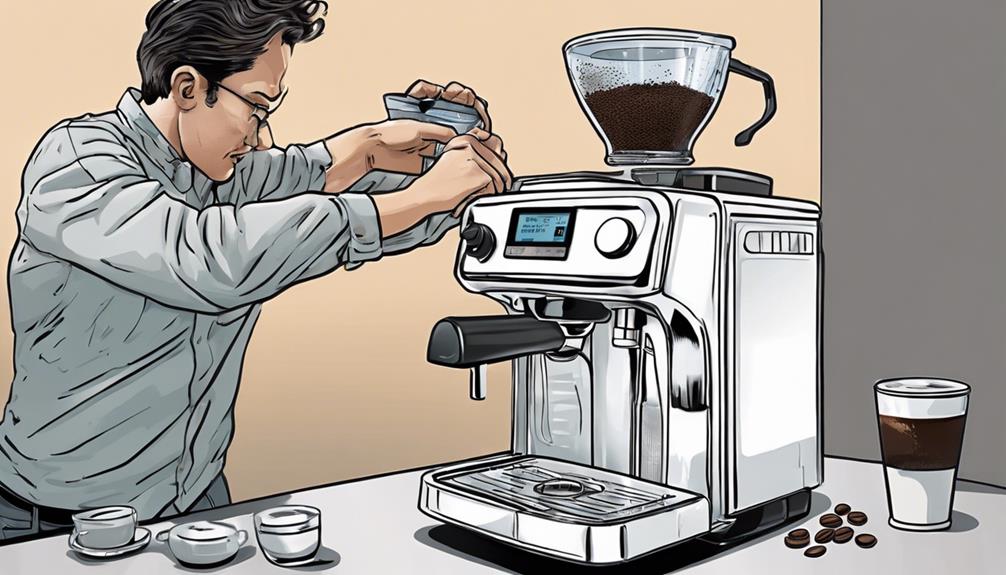
To master the brewing process, focus on filter preparation techniques. Adhere to brewing time recommendations. These factors play an essential role in determining the strength and flavor of your coffee.
Filter Preparation Techniques
For proper filtration during the brewing process, consider folding the cone filter edges or placing a flat filter in the basket. This step guarantees that your coffee is free from any unwanted particles.
When preparing your coffee grounds, using a medium grind size is vital for ideal extraction. Adjusting the grinder setting accordingly and noting it down for future use will help maintain consistency in the grind size and flavor of your coffee.
Before starting the brew cycle, make sure to place the coffee grounds in the filter basket. This simple yet necessary step sets the foundation for a well-brewed cup of coffee.
Once everything is set, allow the brew cycle to run for 3-5 minutes. This time frame allows the water to effectively extract the flavors and aromas from the coffee grounds, resulting in a delicious and satisfying brew.
Brewing Time Recommendations
Consider the impact of brewing duration on the strength and flavor of your coffee as you progress through the brewing process. To achieve optimal brewing outcomes, aim for a brewing duration of 3-5 minutes after starting the brew cycle.
Remember, adjusting the brewing duration can significantly impact the flavor of the coffee. If the brewing duration is too long, over-extraction may occur, leading to a bitter taste in your brew. On the other hand, if the brewing duration is too short, the coffee might be under-extracted, resulting in a weak or sour flavor profile.
It's crucial to experiment with different brewing durations to find the perfect balance that suits your taste preferences. By fine-tuning the brewing duration, you can enhance the overall taste experience of your coffee and make sure that each cup is brewed to perfection.
Fermentation
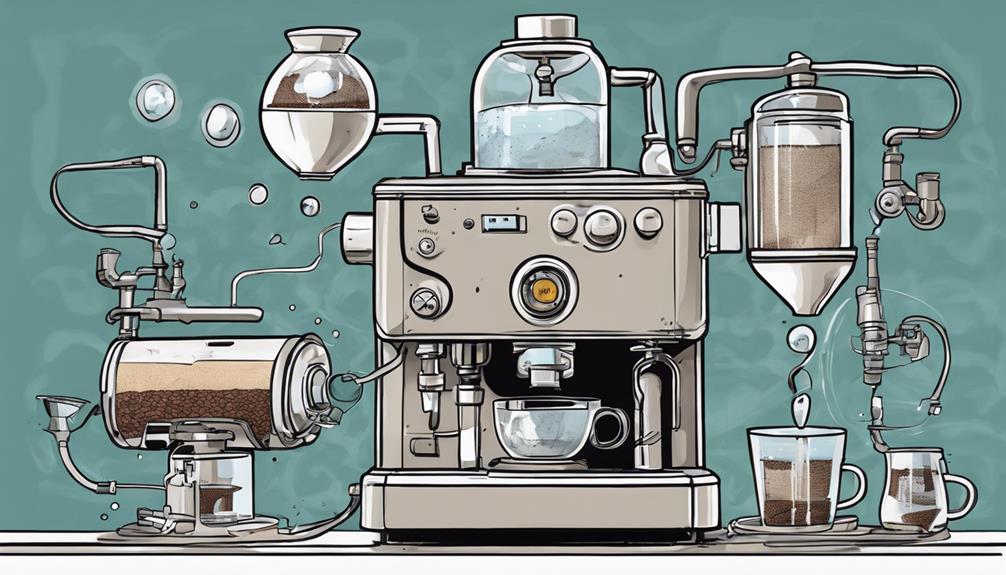
Now, let's talk about fermentation.
Yeast and fermentation, temperature control methods, and brewing time considerations are key points to keep in mind.
Understanding these aspects will help you master the art of brewing your perfect cup of coffee.
Yeast and Fermentation
During fermentation, yeast plays a vital role in converting sugars into alcohol and carbon dioxide in the brewing process. Yeast is an important ingredient in the fermentation process of brewing beer. This process occurs over 5-7 days, allowing the yeast to work on converting sugars into alcohol, which gives beer its alcoholic content.
Fermentation is where yeast consumes sugars in the wort to produce alcohol and carbon dioxide. Proper temperature control during fermentation is crucial as it influences yeast activity and flavor development. The temperature must be carefully maintained to ensure the yeast functions at its best and to achieve the desired flavor profile.
Flavor development is a key aspect of fermentation, where the yeast transforms the sugars into alcohol, contributing to the final taste and aroma of the beer. The fermentation stage is pivotal in determining the ultimate flavor, aroma, and alcohol content of the beer, making it an essential step in the brewing process.
Temperature Control Methods
Maintaining consistent temperature control during fermentation is important for optimizing yeast activity and ensuring the desired beer characteristics are achieved.
To control the temperature effectively while brewing coffee, consider the following:
- Keep the water temperature steady: Aim for a temperature range of 60-70°F to provide the ideal environment for yeast to thrive.
- Monitor and adjust as needed: Since yeast fermentation generates heat, be prepared to adjust the temperature to prevent it from exceeding the desired range.
- Use a reliable thermometer: Accurate temperature measurements are essential for maintaining control over the fermentation process and achieving the desired beer flavors.
Brewing Time Considerations
To maximize flavor development, consider the brewing time for fermentation in the range of 5-7 days when preparing your beer. During this period, the coffee grounds undergo a transformation essential for the overall taste of your brew.
Just like in beer fermentation, maintaining the right conditions is critical for the best results. In the brewing process, ensuring fresh coffee and proper aeration are key factors that impact the final flavor profile.
Similar to how yeast activity is crucial in beer fermentation, the extraction of flavors from coffee grounds is influenced by various brewing factors. By understanding the importance of time in the coffee maker, you can enhance the taste and aroma of your coffee.
Allow the brewing process to unfold naturally, akin to the fermentation of beer, to achieve a delicious cup of coffee every time. Remember, time plays a significant role in both beer and coffee preparation, so savor the process and enjoy the end result.
Final Steps

Before completing the assembly of your coffee machine, make certain all components are securely attached and properly aligned. Once you have verified everything is in place, you're ready to move on to the final steps:
- Fill the Water Reservoir: Check the water reservoir of your coffee maker and top it up with the appropriate amount of water according to the machine's capacity.
- Measure the Coffee: Depending on the desired coffee flavor and the amount of coffee you want to make, measure the coffee grounds using the provided scoop or a scale for precision.
- Double-Check Settings: Before starting the brewing process, review the settings on your coffee machine to confirm the brewing strength and quantity are set to your preference.
Brewing Basics
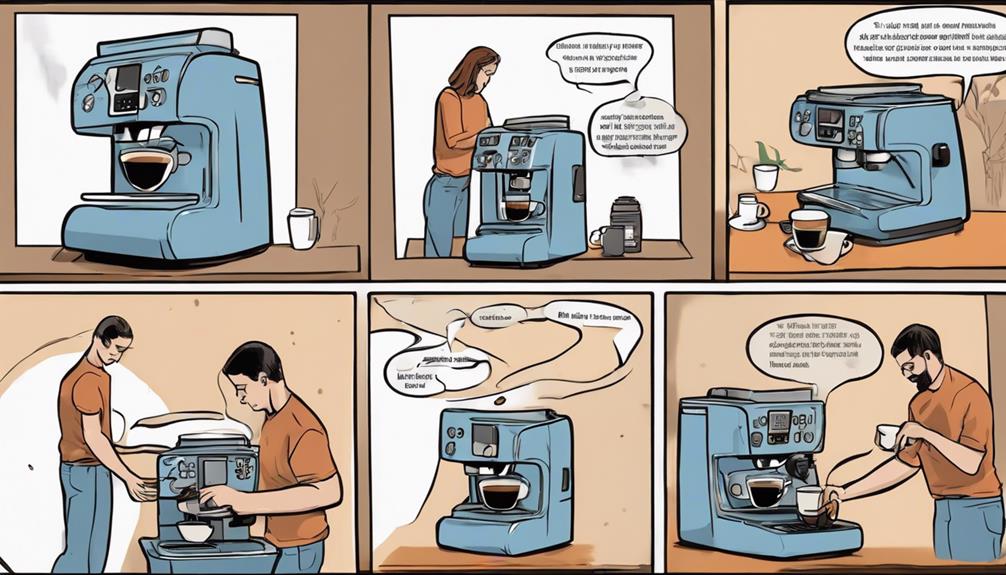
Understanding the brewing basics of your coffee machine is vital for creating the perfect cup of coffee. When it comes to coffee brewing, knowing how to assemble your coffee maker correctly is the first step towards a successful brewing process. Make sure all components are in place to avoid any mishaps during brewing. Starting and stopping the brewing cycle at the right times is pivotal in mastering your coffee maker and achieving the desired coffee strength.
Additionally, proper maintenance and cleaning routines are key to ensuring the longevity of your coffee machine. Regularly cleaning your coffee maker helps prevent clogs and build-up that can affect the taste of your coffee. Experimenting with different coffee blends and grind sizes can also enhance the flavor of your brewed coffee.
Starting the Brewing Process
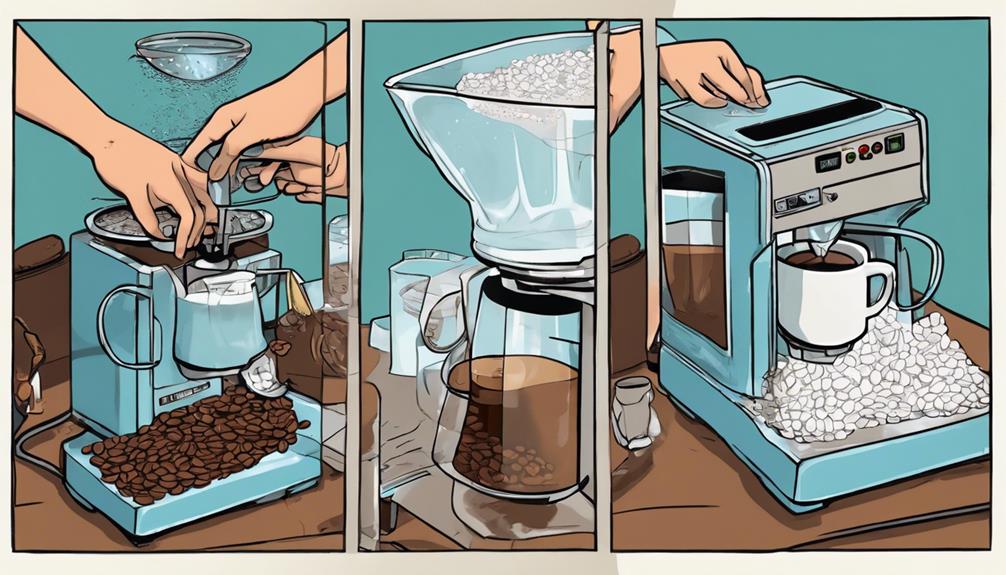
To begin the brewing process, add 45 oz / 1250 ml of cold, filtered water to the reservoir for best flavor extraction.
Using a water filter or bottled water can improve the taste of your coffee, ensuring a delightful experience.
Remember to adjust the water amount if making iced coffee to achieve your desired strength.
Add Water to Reservoir
Fill your coffee maker's water reservoir with 45 oz / 1250 ml of cold, filtered water to kickstart the brewing process. Proper water measurement is important for a well-brewed pot of coffee. Make sure you follow these tips for adding water to the reservoir:
- Use the Recommended Amount: Always stick to the suggested amount of water specified for your coffee maker to achieve the perfect brew consistency.
- Start with Cold Water: Cold water is ideal for brewing as it helps extract the flavors from the coffee grounds effectively.
- Avoid Distilled Water: Steer clear of using distilled water, as it can change the taste of your coffee and impact the brewing process negatively.
Use Filtered Water
Using filtered water in your coffee machine is necessary for enhancing the flavor of your brewed coffee. Filtered water helps to avoid impurities that can negatively impact the taste of your coffee.
When brewing, opt for cold, filtered water as it's ideal for extracting the best flavors from your coffee grounds. If filtered water is unavailable, bottled water can serve as a good alternative, ensuring a cleaner taste in your cup of coffee. It should be noted that distilled water should be avoided as it may not effectively extract the desired coffee flavors, resulting in a bland brew.
Adjusting the amount of water used in your coffee machine is vital, especially when experimenting with different brewing methods or when making iced coffee. By using filtered water, you're taking a simple yet significant step towards improving the overall taste and quality of your coffee.
Preparing the Filter and Coffee
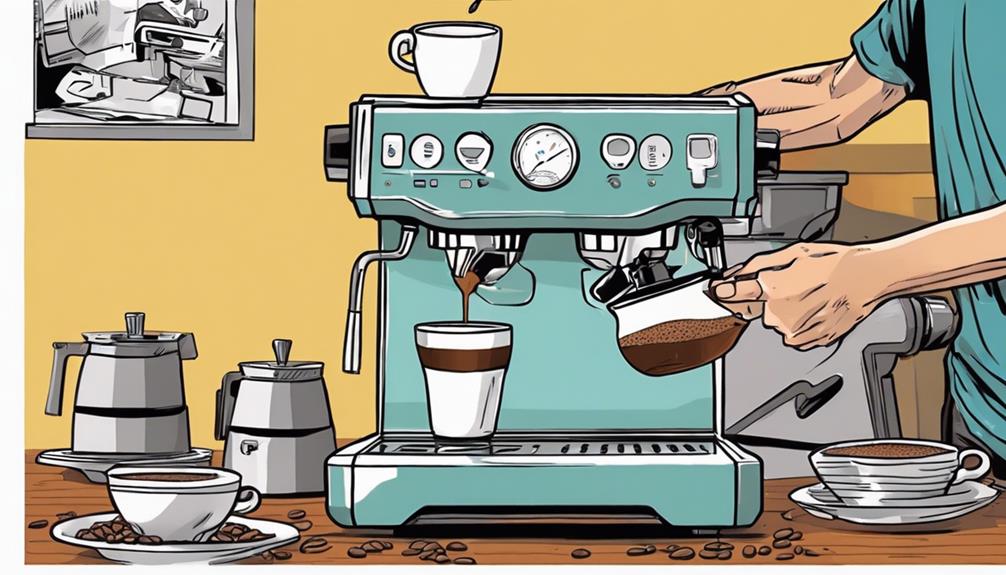
When preparing the filter and coffee for your coffee machine, remember to fold the edges of a cone filter or place a flat filter in the basket for best brewing. Guarantee a medium grind size when using fresh coffee to achieve peak extraction.
Take note of the coffee grinder setting for future uniformity in flavor.
Before starting the brew cycle, place the coffee grounds in the filter basket to begin the brewing process.
- Use the suitable grind size for fresh coffee.
- Remember to record the grinder setting for future use.
- Place the coffee grounds in the filter basket before starting the brew cycle.
Serving and Enjoying Your Coffee
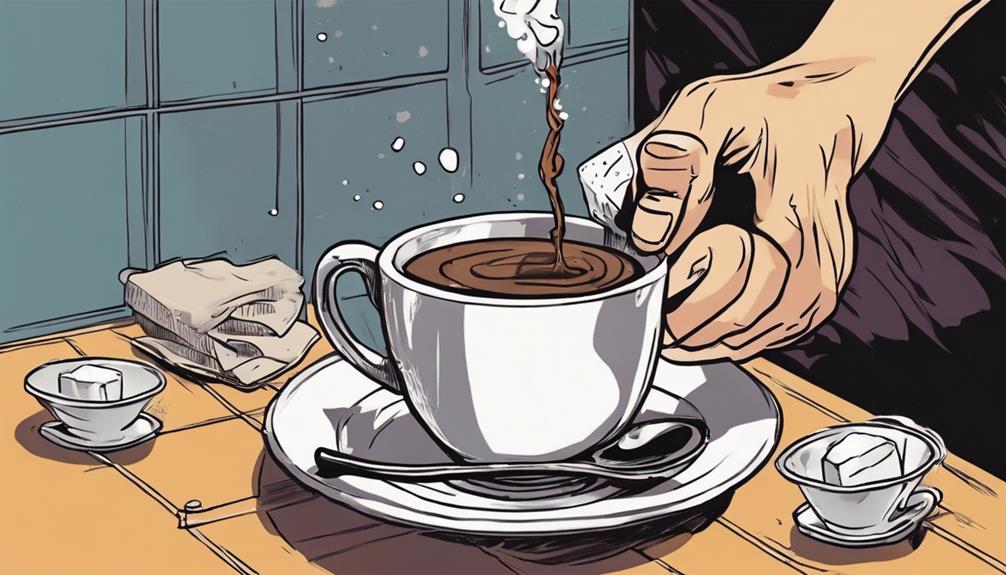
For best enjoyment, always transfer any leftover coffee to a thermos to maintain warmth and freshness.
Avoid leaving the glass carafe on the warming plate, as this can lead to burnt coffee.
When serving your freshly brewed coffee, consider adjusting the grind size based on your taste preferences to achieve peak flavor.
Experiment with different grind coarseness levels to explore diverse flavor profiles in your coffee.
Additionally, adjust the amount of coffee used in your coffee maker to achieve the desired strength, whether you prefer a stronger or milder brew.
Troubleshooting Common Issues
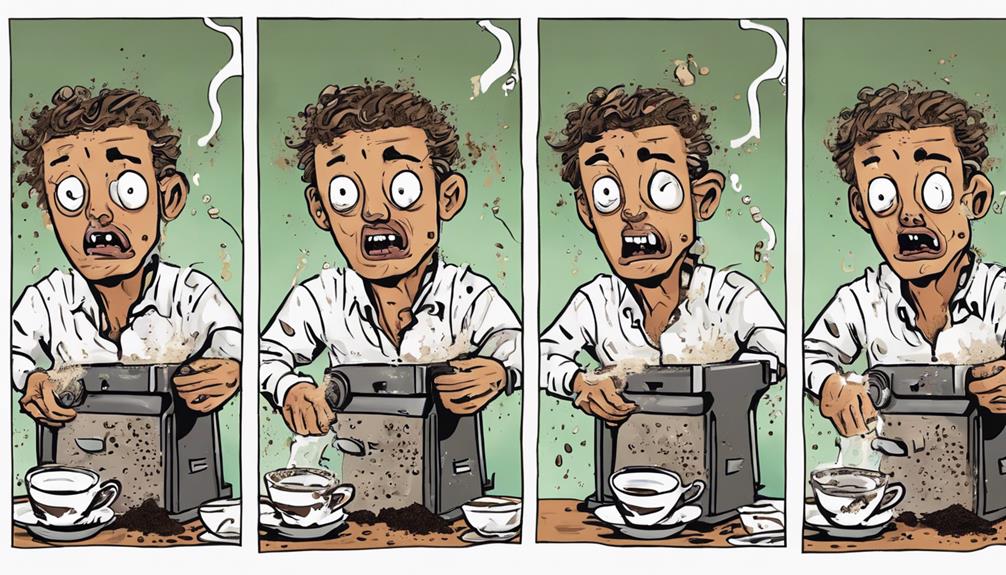
To troubleshoot common issues with your coffee maker, start by addressing any off-flavors in your coffee to guarantee a satisfying brew every time.
If you notice bitterness, adjust the coffee-to-water ratio; for weak or sour taste, clean your coffee maker; and for a burnt flavor, check the water temperature.
Using freshly ground beans can enhance the overall flavor profile, preventing your coffee from tasting old or stale. Remember, the key to a perfect cup of coffee lies not only in the machine but also in the quality of ingredients and maintenance.
By following these simple steps, you can make sure that your coffee always tastes just right.
If despite these adjustments your coffee still isn't hot enough, it might be time to inspect the heating element or wiring for any issues.
With a little troubleshooting and care, you can enjoy delicious coffee from your machine every day.
Frequently Asked Questions
How Do You Organize a Coffee Machine?
To organize a coffee machine, keep all parts together for easy access. Store filters, grounds, and water nearby. Use containers for accessories. Label parts for quick identification. Remember to clean and maintain regularly for best performance and longevity.
How Do You Assemble a Coffee Siphon?
To assemble a coffee siphon, attach the upper and lower chambers securely. Make sure the filter is in place. Connect the chambers by aligning the seals. Place on heat source and follow the manufacturer's instructions for brewing.
How to Use a Coffee Machine Step by Step?
To use a coffee machine step by step, start by placing the coffee filter, measuring coffee grounds and water, and assembling all components. Confirm the machine is turned on correctly. Follow the manufacturer's instructions for specific settings and features. Enjoy your coffee!
How to Plumb a Coffee Maker?
To plumb a coffee maker, connect it directly to a water line for seamless brewing. Enjoy continuous supply without the hassle of refilling. Professional installation guarantees proper function. Keep up with maintenance to avoid clogs and maintain peak performance.
Conclusion
Now that you've assembled your coffee machine, it's time to brew up a delicious cup of joe and kickstart your day!
Remember, just like a well-oiled machine, a good cup of coffee requires the right ingredients, equipment, and brewing process to guarantee a perfect result.
So go ahead, press that button and watch the magic happen as your coffee machine transforms those simple beans into a rich and flavorful experience for your taste buds.
Cheers to a great brew!
